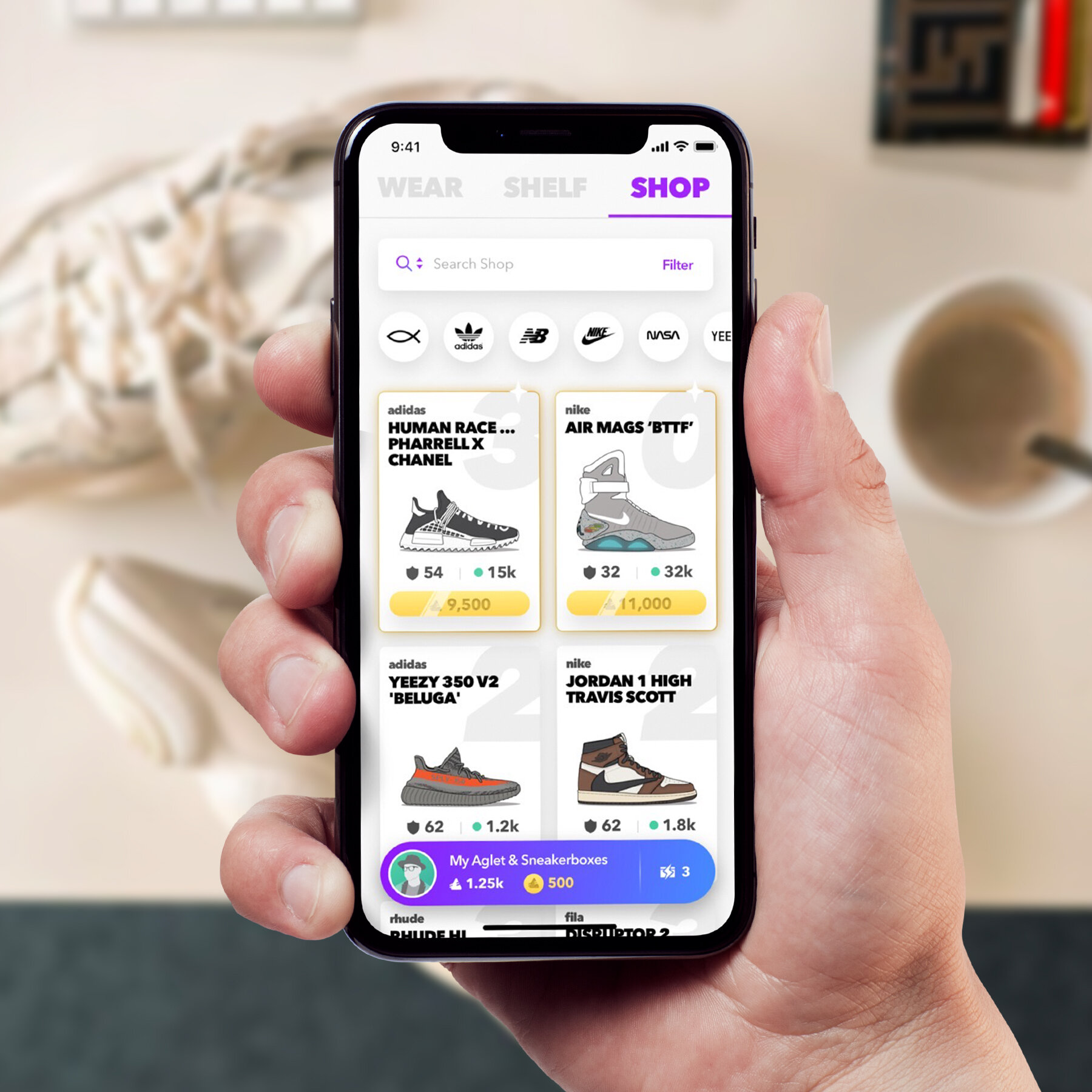Aglet Founder Ryan Mullins Speaks On Building His Virtual Sneaker App
Aglet Founder Ryan Mullins Speaks On Building His Virtual Sneaker App, Bridging The Gap Between Virtual and Reality, Dealing With Self Doubt As A Creative, Helping Like-Minded Entrepreneurs Thrive In The World of Virtual Shopping And More.
Aglet
If you are fully immersed in the sneaker culture and follow it the way many have, you understand how much it has changed over the years. There was a time when you were able to walk into a store and purchase your favorite sneakers with no hassles. Today, purchasing a pair of exclusive kicks is like a wild goose chase where in the end, you may never catch that goose. You’ll either stand in line for hours, or due to COVID-19 and most businesses still being closed, you may find yourself on multiple apps like GOAT or NIKE SNKRS trying to find a reasonable price only to be told you “Didn’t Get ‘Em.” It’s like a heartbreak waiting to happen. Ryan Mullins, a former Adidas employee, created a way where the ultimate sneakerhead can not only grab his/her favorite kicks physically but also own them virtually on their phone.
Aglet, the app that Highsnobiety called the “Pokemon Go” for sneakers, launched April 12th in the middle of a nationwide lockdown. Despite limited movement by the everyday human due to being quarantined, Aglet still managed to gain over 50,000 users in just a few weeks post-launch. Bridging the gap between the virtual world, a world that we’ve been excessively living in the last 4 months, and our reality is what Aglet is striving to accomplish.
I had the pleasure of catching up with Ryan, the founder of Aglet, to discuss the app and it’s creative process. We also talked about how he got into fashion and the sneaker culture, the life of a creative/entrepreneur, building out a space that contributes notoriety to an up and coming designer and more. Read the full interview below.
1 - Let’s talk about the beginning. How did you get involved in fashion, particularly sneakers?
I’ve been collecting sneakers since my teenage years. So, I’ve got an embarrassing number of sneakers in storage, shelved, around the house, etc. The Jordan 11 was really the first piece of footwear that made me realize there’s a difference between a “shoe” and a “sneaker”. A “shoe” is the physical, merely the material. It’s sheer utility. But, a “sneaker”. Well, that’s something else entirely. Sneakers are stories, myths, culture. That’s what I really fell in love with. Michael Jordan (or, really, “Michael Jordan”) and Nike really created this idea of sneakers, objects of desire that exceed mere physical properties. You put on a Jordan and felt transformed. You felt superheroic. You could fly. You could “be like Mike.” Sneakers are one of the great consumer products of all time insofar as they exhibit the religious structure of capitalism. The feeling of transformation by owning and consuming products from the world’s great brands.
But, I would also say that it wasn’t simply the Jordan 11. It was also the entire interest and social graph in which I lived. Basketball, hip-hop, film, etc. Sneakers always seemed to be front and center of culture, driving it forward into new territory. I hope that doesn’t go away. But, lately, it feels like it has flatlined. Like it needs some CPR.
2 - What were some major things that drew you into the streetwear and sneaker culture?
Definitely the storytelling. Again, it’s so much more than just this physical thing that we lace up on our feet. It’s about self-expression, style, community, transformation. That feeling one gets putting on a Jordan or a Yeezy. Like you’re making a statement about who you are and what you stand for. It’s signaling in many ways but I don’t think it’s empty signaling.
Also, most of the people to whom I looked for inspiration were sneakerheads. So, there was something common that mobilized us to discuss, debate, buy, sell, trade, etc.
I also think that the sneaker industry is one of the greatest entrepreneurial success stories in the history of capitalism. Not just Nike, Adidas, New Balance, etc. But, how many businesses and brands have been built around and within “the sneaker industry”? Streetwear, for example, has basically grown to dominate global fashion and emerge as the default style of youth culture. Something that grew out of skateboarding culture and black culture now dons every creative director in the world’s top luxury houses.
In the spirit of entrepreneurialism, I also felt that the design and innovation of sneakers was something that was underrated. Each year new technologies, materials, patterns, references, colorways, manufacturing would emerge and keep things fresh and new. Indeed, it wasn’t anything exponential like in software. There’s not a Moore’s Law equivalent of sneaker development. But, I do respect the work that goes into the design and manufacturing of sneakers to keep pushing forward and testing the limits of what’s possible.
That’s what I really love about Kanye West and the Yeezy brand. I’m interested in future classics. Like, I really hope when my son goes off to high school (it’ll be a while, he’s 4.5) he’s not wearing Jordan 1s. Now, nothing against Jordan 1s. Love ’em. Greatest sneaker of all time. But, where’s the new stuff? It seems likely that the Yeezy 350 V2 will be the Jordan 1 of my son’s generation.
3 - Let’s talk about Aglet. Launched it in April, generated over 50,000 users in a matter of a few weeks. Walk me through that process of creating this idea post-Adidas? How did the idea come about and why did you feel this was an idea that was needed within the sneaker market?
Aglet
Everything in the sneaker industry just felt stale and boring. Brands had tried to own the entire customer journey in virtue of owning their ecosystem. So, the direct-to-consumer business model enabled them to capture more of the revenue and break free, to some extent, of wholesale businesses. But, the growth of sales over the past 5 years largely emerged as a result of the hype-drop mechanism and artificial scarcity to drive up value. As a result, bot culture emerged. And, instead of direct-to-consumer, brands invented a direct-to-bots market. The most desired sneakers and streetwear ends up almost exclusively in the hands of resellers who are interested only in flipping the products for profits. And, no shade being thrown here. I flip sneakers. We all do. Nothing wrong with it at all. Same as Bitcoin. Most BTC owners aren’t people going out and buying shit with it. It’s a store of value. Or, depending on the market, it’s asset reallocation. But, the issue is that the sneaker industry has become so lopsidedly bot-driven that I was thinking of alternative ways of having fun again.
I was playing a lot of Pokemon Go and realized almost immediately that I wanted to create Aglet. I felt like this is how I actually shop for sneakers. Shopping, to me, has become a game. It’s like a quest in which I’m competing against others to get the object of desire. And, I’ve got to come up with various strategies to cop the item before they do. Sneakerheads are gamers.
My favorite novel is called Snow Crash. I’ve probably read it 10x. It’s the first book to use the word “metaverse”. Since I read that and watched the Matrix, I wanted to create the metaverse. So, while playing Fortnite, and seeing how much money I was spending on virtual skins, and remembering how intensely involved I was in playing Second LIfe, it also became clear that I wanted to create something like a Pokemon Go for sneakers.
But, it wasn’t just that. It was more that I wanted to create a new platform for commerce and creation. I wanted to fuse virtual and physical. Aglet is my attempt to do precisely that.
Aglet
4 - During the creation process of Aglet, was there any sort of self-doubt? If so, what was it?
Entrepreneurship isn’t easy. The media tends to focus on the success stories. But, if you’re starting a new company, there’s a near 100% chance that you’re going to fail. Some cultures don’t fear failure though. Some people don’t fear failure. They don’t see failure; they see learning. They see challenges. So, I try to change my perspective on setbacks, obstacles, getting lots of no’s, rejection, etc. There’s a great graph someone made that exhibits the mental journey of a founder. Here it is:
That seems to capture it pretty well.
I look at the job of an entrepreneur as predominantly comprising communication. More specifically, innovative entrepreneurs inhabit a space of non-sense. They see 5-10 years into the future, imagine behaviors, business models, and technologies that lead most people to laugh, say “that’ll never happen” or “that’s nonsense”. And, those people are right. It is nonsense. It most likely doesn’t make sense right now in the current model we use to understand the world. But, that’s okay. That’s what your job is as an entrepreneur. You’re trying to make sense. Your job is to make the nonsense sensical. Catch the world up with your vision.
There’s a great quote from the German philosopher Arthur Schopenhauer: “Talent hits a target no one else can hit; genius hits a target no one else can see.”
5 - The app launched in the middle of a global pandemic/quarantine/lockdown. This meant that the app wasn’t going to be as useful for the user as it was meant to be because no one was outside unless it was essential. You and your team created “pandemic mode” which allowed the user to still go anywhere on a Google Map to play the game. What sort of launch plans did you and your team have for Aglet? Secondly, from your standpoint, how do you make up for not being able to do something physically by doing it virtually?
We planned a local launch, Los Angeles in particular. The company will be based there at some point. So, we had everything planned out. But, like the great philosopher Mike Tyson once said, “Your plan goes out of the ring once you get punched in the face.” Corona punched us in the face. We wanted to focus on LA and then some other cities in California. From there, scale-out to particular cities, leveraging the learnings we’d accumulate. Instead, our team was distributed around the world and a bit nervous about releasing the product, a location-based game to the world. I mean, it’s probably the worst time to release a location-based game right now! But, our testers were adamant that we release. They were still going on 30-minute solo walks or 60-minute jogs. So, we decided to release a very minimal version of the game. It’s basically just the core game loop with zero social features. And, that was the idea. A minimum viable game would be released. We wanted a few thousand players at the end of our first 30 days. And, instead, we got 50k.
Aglet
Aglet
Aglet
6 - In a recent interview, you said you wanted to build a virtual design platform where kids can build their own brands for virtual fashion brands and put them into this game environment for the first phase. I know we’re about two months removed since the launch but are we still in phase 1? If so, what are some of the plans you and your team have to connect with like-minded creatives and entrepreneurs who have an interest in the sneaker culture?
Yes, that’s my dream. Phase 1 of Aglet is something like a Pokemon Go meets virtual Foot Locker. You’re walking around the world, earning Aglet, and then buying and collecting heat for your shelf. So, it’s player focused. But, I want Aglet to be a multi-sided marketplace. That is, I want players, brands, and designers interacting with each other, buying and selling to each other, challenging each other, etc. And, this goes way beyond sneakers. We’ll be releasing avatars into the game soon, which means we’ll also have hoodies, jeans, jewelry, hats, tees, etc. You can build your own virtual fashion brand on Aglet. Have your own shop. We will supply the tools for this. I think of YouTube as a virtual world. Think of someone like Justin Bieber. We first engaged with him as a virtual character on his YT channel. But, someone discovered him and then “brought him into reality” and he became a pop star outside of the YT virtual world. I see the same thing happening with Aglet. The cost of entry to design your own virtual fashion goods and sneakers is incredibly low compared to doing it all in reality. But, I’m not saying don’t do it in reality. I’m just saying that, given that more and more people are spending more and more time in virtual environments, that’s where the eyeballs are. Games are the new social networks and, thus, the new mall. That’s where commerce is going to happen in the future. So, you should be designing, first, in a virtual environment and, when your ish pops, then you’ll find more than enough brands that will want to manufacture it! You can already build a following around your stuff, measure demand, etc. I really can’t wait for this. I want the next Tinker Hatfield or Jason Mayden to come out of Aglet.
7 - Can you elaborate more on the Smart Aglet Sneaker Studio? I personally think it’s a great idea but can you speak more to that and how it can help creatives get their ideas out in the virtual space?
I’m thinking of smartASS as akin to XCode. A creative space where you can design and assemble and, ultimately, publish your sneakers into your shop on Aglet. I look at sneaker design like how airplanes or cars are constructed. That is, they contain components. Midsoles, uppers, laces, aglets, insoles, outsoles, etc. It’s like DNA with base pairs and accidental attributes. So, I’m imaging designers creating not only whole sneakers but also creating components to sell and share in the community. Like, you could just design laces. You could just design midsoles, etc. It’s no different than, say, Github for developers who share code with each so that people don’t have to start from scratch. Or, same with the Unreal Engine. No one wants to start from scratch.
I also want this to be educational. Just become you can illustrate a sneaker doesn’t mean that you can design a sneaker. So, it would be my dream to also make the construction of the digital sneaker educational. I want videos from the best, like Masterclass, teaching you how to design sneakers. And, you can leverage that knowledge in your designs and publishing your work into the shop for people to purchase!
8 - What are some things you guys are doing to continue building out phase 1? What ideas do you and the Aglet team have for phase 2?
The rest of this year will be about adding additional layers to the game. That said, we’re not a game company nor are we a game studio really. We’re a new category. Aglet is a location-based commerce platform reimaging the future of commerce and creativity. But, in order to get there, we need to flesh out the platform. We’re releasing a marketplace later this year for a secondary market. I’ve already mentioned avatars. We’ve got some amazing brand partnerships in the works, further converging the physical and digital. Achievements, rewards, etc. And, of course, we’ve got our AR workstream that we’ve opened up that I think is going to blow people’s minds. I showed this to you already!
9 - How do you see Aglet changing the way people view the sneaker culture?
We want to have fun and push things forward. I don’t see digital as mere e-commerce. Seems to me that sneaker culture has been reduced to a transaction. And, that’s a shame. Thank Zeus for Complex, Hypebeast, Highsnobiety keeping things interesting and fresh. The beauty of sneaker culture is the culture. Go to Complexcon and look at the diversity of races, ethnicities, genders, etc. I believe that we can fuse virtual and physical to create a magical experience for the next generation of sneakerheads...and have a good time doing it.
Aglet is available now in the App Store. Also, be sure to follow Aglet and stay updated on their journey @AgletApp.







